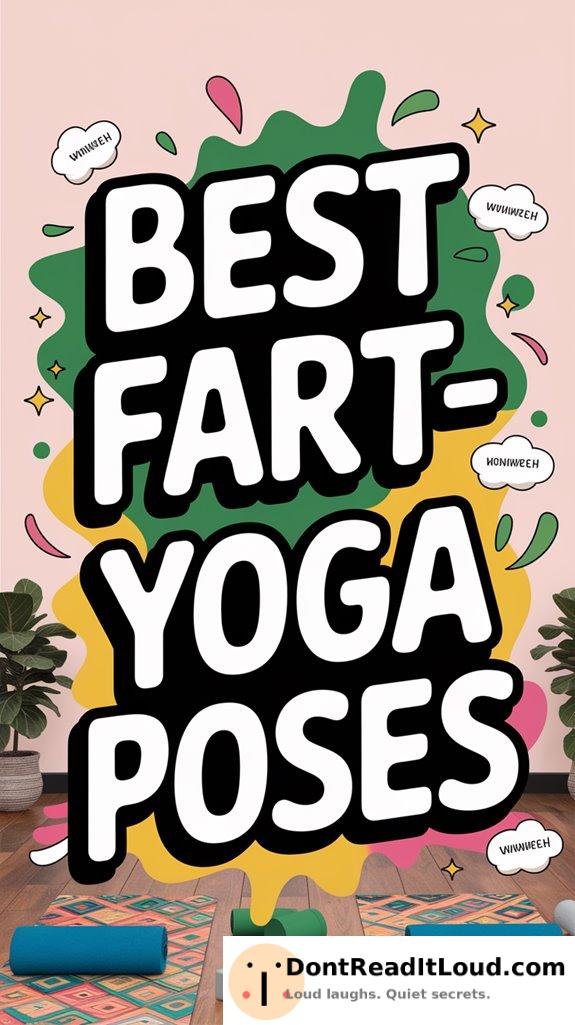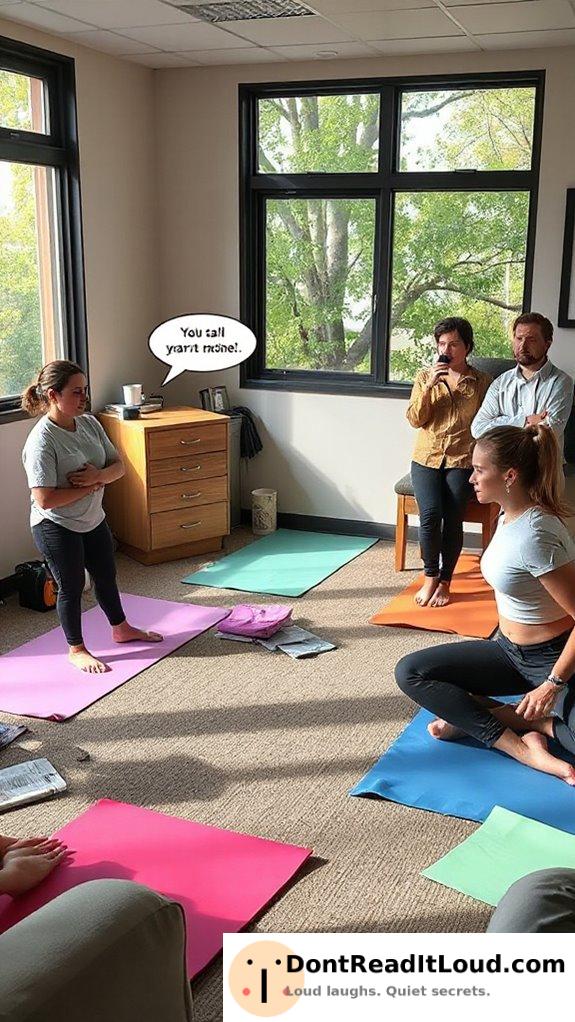
If you’re looking for fart-safe yoga poses, stick with gentle, upright positions that won’t put pressure on your belly. Try Child’s Pose with wide knees, Reclined Butterfly, Mountain Pose, Warrior I, and Tree Pose. These poses let your core stay relaxed and support easy breathing, reducing the chance of unwanted gas. Take slow, controlled breaths and steer clear of deep twists or tight forward folds. There are plenty of other techniques to help keep your practice comfortable and worry-free.
Understanding Why Gas Happens During Yoga

Although yoga encourages relaxation and flexibility, it can sometimes lead to unexpected gas.
Moving through various poses stretches and compresses your abdomen, which can stimulate digestion. This often pushes trapped air or gas through your intestines, causing you to pass gas. It’s a normal response and actually shows that your digestive system is working well.
Certain poses, such as twists or forward bends, put more pressure on your belly and may make gas release more noticeable.
If this concerns you, remember that many people experience it during yoga. You can try modifying your practice with gentle twists or less intense folds to reduce abdominal pressure.
Choosing the Right Yoga Mat and Space

When setting up for your yoga practice, the right mat and environment can greatly improve your comfort and ease—especially if you’re worried about unexpected gas.
Start by looking at yoga mat materials. Thicker mats made from natural rubber or high-density foam give better support and can help muffle sounds. Thin or slippery mats often lack enough cushioning and privacy.
Next, check how well the studio is ventilated. Good airflow quickly disperses odors and keeps the space feeling fresh, which helps ease concerns. At home, open a window or use a fan for better air circulation. In a studio, try to set up near a vent or door if you can.
Focusing on both your mat and the room’s ventilation helps ensure a more comfortable, stress-free practice.
Poses That Minimize Abdominal Pressure

If you want to avoid awkward gas during yoga, choose poses that ease pressure on your abdomen.
Gentle postures like Child’s Pose with wide knees or Reclined Butterfly Pose let your belly stay soft and relaxed. These positions don’t squeeze your digestive tract, reducing the chance of unexpected gas.
Pay attention to your breath and let your stomach relax each time you exhale. Steer clear of deep twists or forward crunches, as they can increase abdominal pressure.
Selecting gentle, spacious poses helps your body feel settled and at ease. This way, you’ll feel more comfortable on your mat and enjoy a smoother yoga experience.
Standing Poses for Discreet Practice

Since standing poses keep your torso upright, they provide a subtle way to practice yoga without stressing your belly. For a fart-safe session, try Mountain Pose (Tadasana), Warrior I (Virabhadrasana I), or Tree Pose (Vrikshasana).
These poses emphasize alignment and stability, engaging your legs and core while avoiding extra pressure on your abdomen. You’ll feel grounded and strong without worrying about drawing attention.
In a class or quiet space, standing poses help you blend in and focus on your breath. Pay attention to your alignment—stack your joints, root your feet, and lengthen your spine.
This approach makes your practice both comfortable and discreet.
Gentle Twists for Controlled Movement

Although twists can sometimes spark anxiety about accidental noises, gentle variations help you stay in control of your movements and breath. Move slowly through twist variations to avoid sudden pressure changes that might cause embarrassment.
Begin with a simple supine twist: lie on your back, draw one knee across your body, and keep your shoulders relaxed on the mat. Pay attention to alignment, using your breath to determine how far to rotate.
A gentle seated twist is another option—sit tall and rotate just until you feel a mild stretch. Engage your core for support, and never push past comfort.
Staying present with your breath and body helps reduce surprises so you can enjoy the benefits of twisting with confidence.
Seated Poses to Keep Things Quiet

Seated poses provide a steady base, helping you avoid unexpected noises by keeping movements gentle and controlled. Staying close to the floor reduces sudden shifts that might cause embarrassment.
Poses like Sukhasana (Easy Pose) and Vajrasana (Thunderbolt Pose) let you manage your body with ease, especially when you focus on steady breathing. These positions put less pressure on your abdomen compared to forward bends or deep twists, making them a safe choice.
You can also practice seated meditation, maintaining an upright spine while allowing your core to relax. The calm nature of these poses encourages focus and relaxation, so you can enjoy your practice with confidence.
Choose these grounding shapes for a quieter, more comfortable yoga session.
Breathing Techniques to Reduce Gas

By focusing on your breath, you help your digestive system function more smoothly and lower the chances of gas during yoga.
Begin each session with deep nasal inhales, allowing your belly to rise naturally. This kind of breathing soothes your gut and relaxes your abdomen, which can help prevent air from getting trapped. When you exhale, gently pull your belly button in toward your spine, keeping the movement relaxed and easy.
Maintain slow, steady breaths as you move through your yoga routine. If you feel tightness in your stomach, pause and consciously let that area soften.
Mindful breathing calms your mind and aids in healthy digestion. Using these methods, you can reduce the likelihood of awkward noises and stay comfortable on your mat.
Conclusion
You now have strategies to make your yoga practice comfortable and discreet. Select fart-safe poses, practice mindful breathing, and create a supportive environment. This helps you focus on your flow rather than worrying about unexpected sounds. Remember, everyone experiences gas—it’s completely normal. Don’t let it stress you out. With these tips, you can enjoy yoga confidently and comfortably, free from embarrassment. Happy, peaceful stretching!


